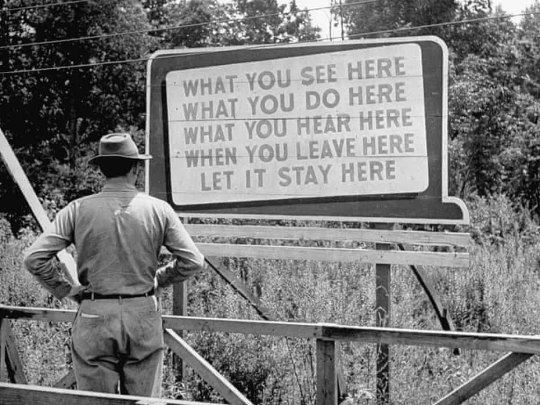#manhattan project
Text

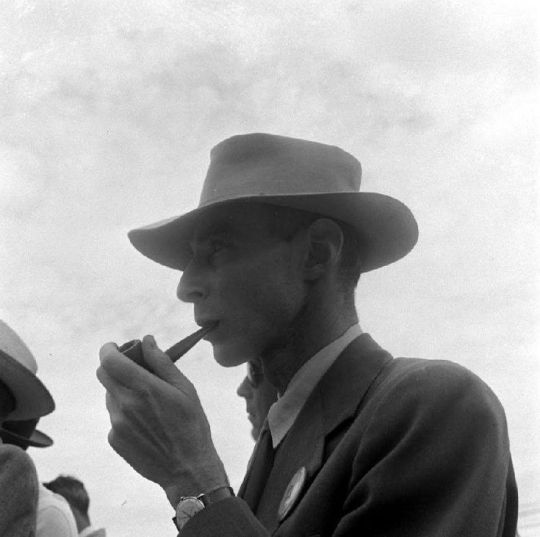
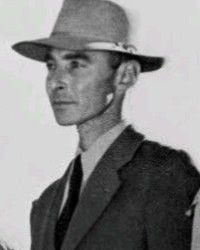
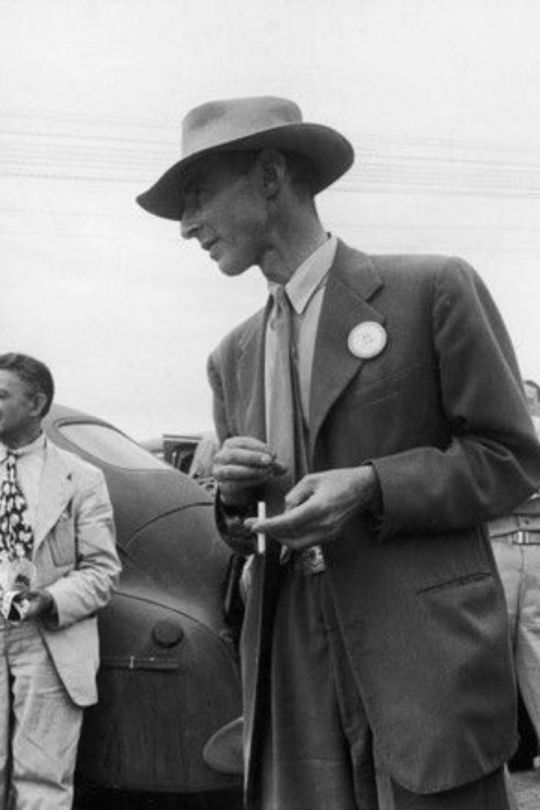
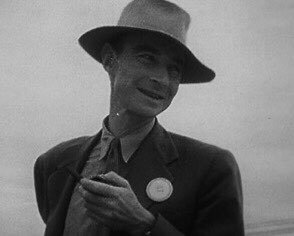
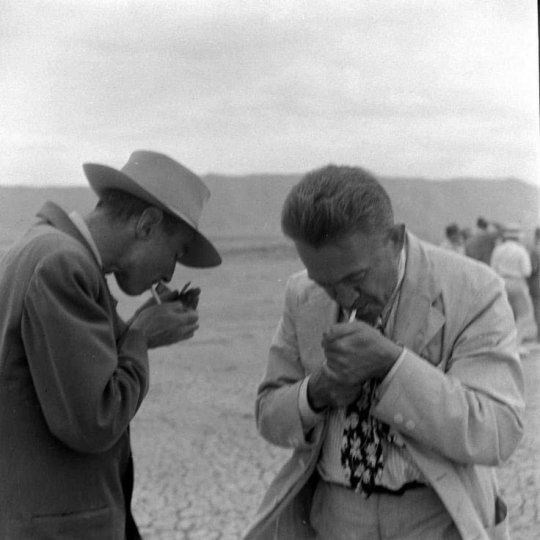
Happy birthday to Robert Oppenheimer who would be 120 today!
22/04/1904
#j robert oppenheimer#oppenheimer#oppie#robert oppenheimer#american prometheus#los alamos#manhattan project#history
15 notes
·
View notes
Text
Today I discovered a mid-century photographer called Philippe Halsman who photographed the famous people of his era, from Richard Nixon to Marilyn Monroe. At the end of his sessions he would ask the person to jump into the air for a picture, believing that this would cause them to drop their pretenses and public persona, leaving him with a picture of the real person as they made their leap. He called this ‘jumpology’.
This is the photo he took of Robert Oppenheimer in 1958, possibly the most free and unreserved image of him that I’ve ever seen.
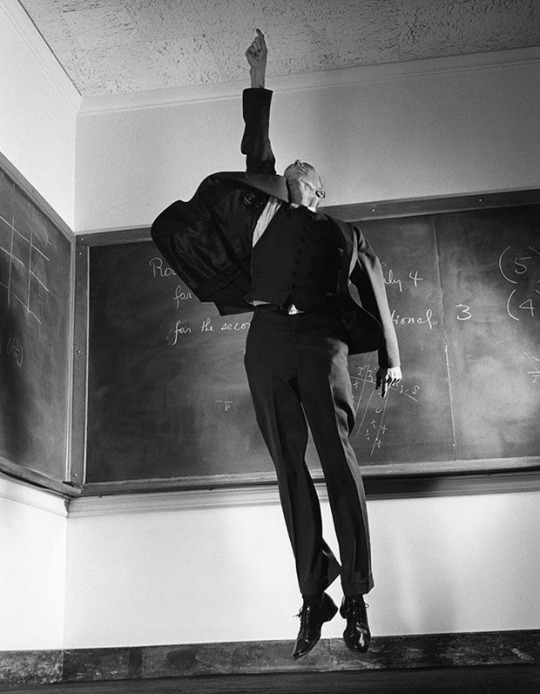
#oppenheimer#american prometheus#1950s#cillian murphy x reader#cillian murphy#oppenheimer x reader#christopher nolan#peaky blinders#tommy shelby#tommy shelby x reader#j robert oppenheimer#history#world war two#manhattan project#philippe halsman#photography
495 notes
·
View notes
Text
So with Oppenheimer coming out tomorrow, I feel a certain level of responsibility to share some important resources for people to understand more about the context of the Manhattan Project. Because for my family, it’s not just a piece of history but an ongoing struggle that’s colonized and irradiated generations of New Mexicans’ lives and altered our identity forever. Not only has the legacy of the Manhattan Project continued to harm and displace Indigenous and Hispanic people but it’s only getting bigger: Biden recently tasked the Los Alamos National Lab facility to create 30 more plutonium pits (the core of a nuclear warhead) by 2026. So this is a list of articles, podcasts and books to check out to hear the real stories of the local people living with this unique legacy that’s often overlooked.
This is simply the latest mainstream interest in the Oppenheimer story and it always ALWAYS silences the trauma of the brown people the US government took advantage of to make their death star. I might see the movie, I honestly might not. I’m not trying to judge anyone for seeing what I’m sure will be an entertaining piece of art. I just want y’all to leave the theater knowing that this story goes beyond what’s on the screen and touches real people’s lives: people whose whole families died of multiple cancers from radiation from the Trinity test, people who’s ancestral lands were poisoned, people who never came back from their job because of deadly work conditions. This is our story too.
The first and best place to learn more about this history and how to support those still resisting is to follow Tewa Women United. They’ve assembled an incredible list of resources from the people who’ve been fighting this fight the longest.
https://tewawomenunited.org/2023/07/oppenheimer-and-the-other-side-of-the-story
The writer Alicia Inez Guzman is currently writing a series about the nuclear industrial complex in New Mexico, its history and cultural impacts being felt today.
https://searchlightnm.org/my-nuclear-family/
https://searchlightnm.org/the-abcs-of-a-nuclear-education/
https://searchlightnm.org/plutonium-by-degrees/
Danielle Prokop at Source NM is an excellent reporter (and friend) who has been covering activists fighting for Downwinder status from the federal government. They’re hoping that the success of Oppenheimer will bring new attention to their cause.
https://sourcenm.com/2023/07/19/anger-hope-for-nm-downwinders/
https://sourcenm.com/2022/01/27/new-mexico-downwinders-demand-recognition-justice/
One often ignored side of the Manhattan Project story that’s personal for me is that the government illegally seized the land that the lab facilities eventually were built on. Before 1942, it was homesteading land for ranchers for more than 30 families (my grandpa’s side of the family was one). But when the location was decided, the government evicted the residents, bought their land for peanuts and used their cattle for target practice. Descendants of the homesteaders later sued and eventually did get compensated for their treatment (though many say it was far below what they were owed)
https://www.hcn.org/issues/175/5654
Myrriah Gomez is an incredible scholar in this field, working as a historian, cultural anthropologist and activist using a framework of “nuclear colonialism” to foreground the Manhattan Project. Her book Nuclear Nuevo Mexico is an amazing collection of oral stories and archival record that positions New Mexico’s era of nuclear colonialism in the context of its Spanish and American eras of colonialism. A must read for anyone who’s made it this far.
https://uapress.arizona.edu/book/nuclear-nuevo-mexico
There isn’t a ton of podcasts about this (yet 👀) but recently the Washington Post’s podcast Field Trip did an episode about White Sands National Monument. The story is a beautifully written and sound designed piece that spotlights the Downwinder activists and also a discovery of Indigenous living in the Trinity test area going back thousands of years. I was blown away by it.
https://www.washingtonpost.com/podcasts/field-trip/white-sands-national-park/
#oppenheimer#oppenheimer movie#barbenheimer#manhattan project#new mexico#los alamos#I never do posts like this#but I felt compelled#theres just so much like nuclear worship going on right now
759 notes
·
View notes
Text


Camera bunker at Trinity Site, New Mexico, where the world's first nuclear weapon was detonated. (Library of Congress)
#history#trinity site#architecture#oppenheimer#bunker#military history#new mexico#desert#ruins#cinematography#manhattan project
1K notes
·
View notes
Text
Robert Oppenheimer and the Manhattan Project knew from the start that this place was not all that isolated and was far from uninhabited.
There were, in fact, dozens of families within 20 miles, largely poor families of ranchers and farmers, many Hispanic and Indigenous, who unwittingly went about their daily lives in the first fallout of the atomic age. Now, those who were infants and children downwind of the detonation of the “Gadget”—a code name for the plutonium bomb used in the Trinity test—are nearing the end of a decades-long battle to be recognized and compensated for generations of illness they trace to exposure from radioactive fallout.
[...]
The reactions of Manhattan Project observers at the Trinity site are well documented. “Words haven’t been invented to describe it,” physicist Val Fitch said of the enormous fireball. General Thomas Farrell said the awesome roar “warned of doomsday and made us feel that we puny things were blasphemous.” “A few people laughed, a few people cried,” Oppenheimer recalled years later. “I remembered a line from the Hindu scripture . . . Now I am become Death, the destroyer of worlds.” Physicist Kenneth Bainbridge said, “Now we are all sons of bitches.”
Less documented are the reactions of the many New Mexicans who lived near Trinity. They had no warning, no context for the star-level explosion that shook their homes and startled them awake that morning. Worse, in the weeks after the test, they were never advised that their land, crops, livestock, and water may have been irradiated. A 2010 report to the CDC used archives at Los Alamos National Laboratory to re-examine the extent to which New Mexicans were unknowingly exposed to radioactive contamination from Trinity. Its findings revealed a shambolic and sometimes cynical effort to track the Gadget’s fallout that windy morning using “crude” and “ineffective” measures. Spotlights were deployed to try to follow the 230 tons of sand and ash falling from the mushroom cloud as it dispersed over southern New Mexico. Film badges designed to detect and measure radiation had been sent to nearby post offices before the test, but because of the Manhattan Project’s secret nature, there was little explanation on how the badges were meant to be used or why, and so they were deployed incorrectly or not at all.
Some soldiers assigned to chase and monitor the radioactive cloud couldn’t relay their findings to headquarters in Albuquerque because they were not equipped with long-distance radios; other monitors attempted to gather fallout samples with domestic Filter Queen brand vacuum cleaners. (These samples were later lost or destroyed.) At least one monitor left the area after his superior declared tracking fallout a “waste of time,” while another soldier misplaced his respirator and took the official but scientifically misguided precaution of breathing through a slice of bread.
269 notes
·
View notes
Text
👊

#wednesday#nes#nintendo#tmnt#teenage mutant ninja turtles#retro gamer#retro gaming#retrogamelovers#8 bit#manhattan project#konami
32 notes
·
View notes
Text

Oppenheimer (2023)
#oppenheimer#christopher nolan#trinity test#manhattan project#cillian murphy#j robert oppenheimer#robert oppenheimer#nuclear bomb#atomic bomb#gif#gifs
21 notes
·
View notes
Text
As the movie Oppenheimer debuts, here's some other content from Shaun about why the Hiroshima & Nagasaki bombings were NOT, in fact, necessary to ending World War II.
youtube
The video goes into great detail about how Japan was looking for ways to surrender, how the USSR's invasion of Japanese occupied territory would have been the end of Japan regardless of the nuclear bombings, and how the USA wanted to assert its own influence at the end of the war.
#oppenheimer#hiroshima#nagasaki#world war 2#manhattan project#history#oppenheimer movie#cold war#Youtube
119 notes
·
View notes
Note
Just saw Oppenheimer and I was a bit disappointed with how they portrayed Truman. He came across pretty poorly IMO. It was only one scene but I wondered what you thought.
I understand your disappointment and it certainly wasn't a very in-depth portrayal of Truman, but according to the book that the movie was largely based on -- American Prometheus: The Triumph and Tragedy of J. Robert Oppenheimer by Kai Bird and Martin J. Sherwin (BOOK | KINDLE | AUDIO) -- the meeting that Oppenheimer had with President Truman went down pretty much as depicted in the film.
As Bird and Sherwin write in American Prometheus:
(O)n October 25, 1945, Oppenheimer was ushered into the Oval Office. President Truman was naturally curious to meet the celebrated physicist, whom he knew by reputation to be an eloquent and charismatic figure. After being introduced by Secretary [of War Robert P.] Patterson, the only other individual in the room, the three men sat down. By one account, Truman opened the conversation by asking for Oppenheimer's help in getting Congress to pass the May-Johnson bill, giving the Army permanent control over atomic energy. "The first thing is to define the national problem," Truman said, "then the international." Oppenheimer let an uncomfortably long silence pass and then said, haltingly, "Perhaps it would be best first to define the international problem." He meant, of course, that the first imperative was to stop the spread of these weapons by placing international controls over all atomic technology. At one point in their conversation, Truman suddenly asked him to guess when the Russians would develop their own atomic bomb. When Oppie replied that he did not know, Truman confidently said he knew the answer: "Never."
For Oppenheimer, such foolishness was proof of Truman's limitations. The "incomprehension it showed just knocked the heart out of him," recalled Willie Higinbotham. As for Truman, a man who compensated for his insecurities with calculated displays of decisiveness, Oppenheimer seemed maddeningly tentative, obscure -- and cheerless. Finally, sensing that the President was not comprehending the deadly urgency of his message, Oppenheimer nervously wrung his hands and uttered another of those regrettable remarks that he characteristically made under pressure. "Mr. President," he said quietly, "I feel I have blood on my hands."
The comment angered Truman. He later informed David Lilienthal, "I told him the blood was on my hands -- to let me worry about that." But over the years, Truman embellished the story. By one account, he replied, "Never mind, it'll all come out in the wash." In yet another version, he pulled his handkerchief from his breast pocket and offered it to Oppenheimer, saying, "Well, here, would you like to wipe your hands?"
An awkward silence followed this exchange, and then Truman stood up to signal that the meeting was over. The two men shook hands, and Truman reportedly said, "Don't worry, we're going to work something out, and you're going to help us."
Afterwards, the President was heard to mutter, "Blood on his hands, dammit, he hasn't half as much blood on his hands as I have. You just don't go around bellyaching about it." He later told [Secretary of State] Dean Acheson, "I don't want to see that son-of-a-bitch in this office ever again." Even in May 1946, the encounter still vivid in his mind, he wrote Acheson and described Oppenheimer as a "cry-baby scientist" who had come to "my office some five or six months ago and spent most of his time wringing his hands and telling me they had blood on them because of the discovery of atomic energy."
#Oppenheimer#History#Oppenheimer Film#J. Robert Oppenheimer#Harry S. Truman#President Truman#Truman Administration#Atomic Bomb#Manhattan Project#Trinity Test#Oppenheimer Movie#Christopher Nolan#Cillian Murphy#Gary Oldman#American Prometheus#American Prometheus: The Triumph and Tragedy of J. Robert Oppenheimer#Kai Bird#Martin J. Sherwin#Nuclear Weapons#World War II
77 notes
·
View notes
Text

Oppenheimer (2023)
🎬During World War II, Lt. Gen. Leslie Groves Jr. appoints physicist J. Robert Oppenheimer to work on the top-secret Manhattan Project. Oppenheimer and a team of scientists spend years developing and designing the atomic bomb. Their work comes to fruition on July 16, 1945, as they witness the world's first nuclear explosion, forever changing the course of history.
📝A truly magnificent film, based on the equally excellent book ('American Prometheus'). It's full of excellent cast and tells us about the Golden Age of Physics as well as the dark age of the bomb. A thought provoking film and Cillian Murphy is just phenomenal. I highly recommend that you watch this in the cinema.
#oppenheimer#r j Oppenheimer#atom bomb#atomic bomb#hiroshima#nagasaki#cillian murphy#robert downey jr.#robert downey jr#robert downey junior#good films#film review#movie review#florence pugh#josh hartnett#chritopher nolan#manhattan project#ww2#second world war#physics#emily blunt
67 notes
·
View notes
Text

Possibly my favourite photograph of Oppie that I have found to date, at home with his son and taken for an edition of Life Magazine in 1949 by Alfred Eisenstaedt, of which he was on the front cover. He just seems so normal here, interacting with his son like any father would, it’s very humanising. Pictures like this are what remind us that historical figures were real people, not just mystical figures of the past that we find in textbooks.
#1950s#oppenheimer#american prometheus#cillian murphy#oppenheimer x reader#christopher nolan#cillian murphy x reader#life magazine#alfred eisenstaedt#photography#j robert oppenheimer#j robert oppenheimer x reader#family life#world war two#atomic bomb#manhattan project
156 notes
·
View notes
Text

Now I Am Become Death, the Destroyer of Worlds v1
By Jeff Stanford, 2023
Buy prints at:
https://jeff-stanford.pixels.com/
#© Jeff Stanford#midjourney#midjourneyart#ai#discord#digitalart#aiart#Artists on tumblr#J. Robert Oppenheimer#atomic mushroom cloud#The Destroyer of Worlds#atomic bomb#scientist#man#Manhattan Project#Trinity test#theoretical physicist
69 notes
·
View notes
Photo

I... a universe of atoms, an atom in the universe.
- Richard Feyneman
Richard Feynman (1918-1988) was an American theoretical physicist who received the Nobel Prize in 1965. Robert Wilson recruited the brilliant young Feynman, only 24 at the time, for the Manhattan Project as a junior physicist soon after completing his Ph.D. At Los Alamos, Feynman was assigned to the theoretical division of Hans Bethe, and soon became a group leader. Feynman was briefly transferred to the Oak Ridge facility, where he aided engineers in calculating safety procedures for material storage so that inadvertent criticality accidents could be avoided. He was well known for playfully challenging the security at Los Alamos, and was present for the Trinity test in 1945, viewing the explosion through his truck windshield.
After the Manhattan Project, Feynman regretted not reconsidering his work after Germany was defeated in World War II, although he continued to feel that the threat of a nuclear-armed Nazi Germany was enough to justify his initial participation. He turned down an offer from the Institute for Advanced Study and joined Hans Bethe at Cornell from 1945 to 1950, where he taught theoretical physics. Feynman left to join the faculty at Caltech in 1950. There he conducted his groundbreaking research in areas of quantum electrodynamics and superfluidity.
Feynman won his 1965 Nobel Prize in Physics for his work in quantum electrodynamics, a formula well known for its accurate predictions, which combines his path integral formulation and his Feynman diagrams. Additionally, he worked in the fields of the physics of superfluidity and quantum gravity, and developed a model of weak decay. However he caused great controversy when shortly after winning the prize in 1965, he seemingly rejected it. Feynman increasingly felt unease at the award turning the scientists into an institution.
It was no strange thing for Feynman to offer an opinion contrary to authority. Often called a buffoon and a magician, Feynman was scolded by the scientific world for his pursuit of things outside science, like art and music. A series of televised lecturers for the public secured his place in the households of millions in the US and the rest of the world. It was here that his excitement and passion for science trickled into the popular psyche and admitted countless young people into the world of science. He loved science and its limitless possibilities of discovery; it is no surprise, then, that he viewed his Nobel Prize with indifference.
#feyneman#richard feyneman#quote#physicist#scientist#nobel prize in physics#nobel laureate#american#caltech#los alamos#nuclear#atom bomb#manhattan project#science#university
82 notes
·
View notes
Text
Christopher Nolan’s highly-anticipated movie “Oppenheimer,” set for release July 21, 2023, depicts J. Robert Oppenheimer and his role in the development of the atomic bomb. But while the Manhattan Project wouldn’t have been possible without the work of many accomplished female scientists, the only women seen in the movie’s trailer are either hanging laundry, crying or cheering the men on.The only women featured in the official trailer for Christopher Nolan’s ‘Oppenheimer’ are crying, hanging laundry or supporting the men.
As a physics professor who studies ways to support women in STEM – science, technology, engineering and math – fields and a film studies professor who worked as a screenwriter in Hollywood, we believe the trailer’s depiction of women reinforces stereotypes about who can succeed in science. It also represents a larger trend of women’s contributions in science going unrecognized in modern media.
Lise Meitner: A pioneering role model in physics
The Manhattan Project would not have been possible without the work of physicist Lise Meitner, who discovered nuclear fission. Meitner used Einstein’s E=MC² to calculate how much energy would be released by splitting uranium atoms, and it was that development that would prompt Einstein to sign a letter urging President Franklin Roosevelt to begin the United States’ atomic research program.
Einstein called Meitner the “Madame Curie of Germany” and was one of a pantheon of physicists, from Max Planck to Niels Bohr, who nominated Meitner for a Nobel Prize 48 times during her lifetime.
Meitner never won. Instead, the prize for fission went to Otto Hahn, her male lab partner of 30 years in Berlin. Hahn received the news of his nomination under house arrest in England, where he and other German scientists were being held to determine how far the Third Reich had advanced with its atomic program.
Of Jewish descent, Meitner had been forced to flee the Nazis in 1938 and refused to use this scientific discovery to develop a bomb. Rather, she spent the rest of her life working to promote nuclear disarmament and advocating for the responsible use of nuclear energy.
Meitner was not the only woman who made a significant contribution during this time. But the lack of physics role models like Meitner in popular media leads to real-life consequences. Meitner doesn’t appear as a character in the film, as she was not part of the Manhattan Project, but we hope the script alludes to her groundbreaking work.
A lack of representation
Only around 20% of the undergraduate majors and Ph.D. students in physics are women. The societal stereotypes and biases, expectation of brilliance, lack of role models and chilly culture of physics discourage many talented students from historically marginalized backgrounds, like women, from pursuing physics and related disciplines.
Societal stereotypes and biases influence students even before they enter the classroom. One common stereotype is the idea that genius and brilliance are important factors to succeed in physics. However, genius is often associated with boys, and girls from a young age tend to shy away from fields associated with innate brilliance.
Studies have found that by the age of 6, girls are less likely than boys to believe they are “really, really smart.” As these students get older, often the norms in science classes and curricula tend not to represent the interests and values of girls. All of these stereotypes and factors can influence women’s perception of their ability to do physics.
Research shows that at the end of a yearlong college physics course sequence, women with an “A” have the same physics self-efficacy as men with a “C”. A person’s physics self-efficacy is their belief about how good they are at solving physics problems – and one’s self-efficacy can shape their career trajectory.
Women drop out of college science and engineering majors with significantly higher grade-point averages than men who drop out. In some cases, women who drop out have the same GPA as men who complete those majors. Compared to men, women in physics courses feel significantly less recognized for their accomplishments. Recognition from others as a person who can excel in physics is the strongest predictor of a student’s physics identity, or whether they see themselves as someone who can excel in physics.
More frequent media recognition of female scientists, such as Meitner, could vicariously influence young women, who may see them as role models. This recognition alone can boost young women’s physics self-efficacy and identity.
When Meitner started her career at the beginning of the 20th century, male physicists made excuses about why women had no place in a lab – their long hair might catch fire on Bunsen burners, for instance. We like to believe we have made progress in the past century, but the underrepresentation of women in physics is still concerning.
Diversity as an asset to science
If diverse groups of scientists are involved in brainstorming challenging problems, not only can they devise better, future-oriented solutions, but those solutions will also benefit a wider range of people.
Individuals’ lived experiences affect their perspectives – for example, over two centuries ago, mathematician Ada Lovelace imagined applications far beyond what the original inventors of the computer intended. Similarly, women today are more likely to focus on applications of quantum computers that will benefit their communities. Additionally, physicists from Global South countries are more likely to develop improved stoves, solar cells, water purification systems or solar-powered lamps. The perspectives that diverse groups bring to science problems can lead to new innovations.
Our intention is not to disparage the “Oppenheimer” movie, but to point out that by not centering media attention on diverse voices – including those of women in physics like Meitner – filmmakers perpetuate the status quo and stereotypes about who belongs in physics. Additionally, young women continue to be deprived of exposure to role models who could inspire their academic and professional journeys'
74 notes
·
View notes
Text
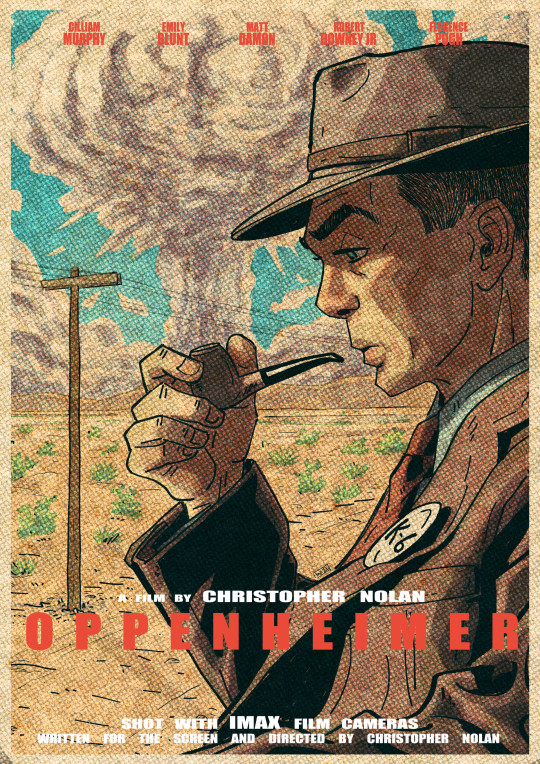
Pop art-like Cillian Murphy as Oppenheimer. Thanks for Wagner Diesel on Artstation.
#oppenheimer#art#atomic bomb#fanart#history of science#manhattan project#oppenheimer fanart#physics#us history#digital art#retro aesthetic#pop art#vintage postcards#film poster#cillian murphy#christopher nolan#american prometheus#fandom#character design#christmas
32 notes
·
View notes
